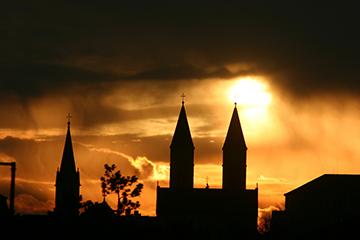 I’ve got my Gospel Glasses on, and my Holy Hearing Aids, and I’m seeing and hearing God in strange places. There are several Paul Simon songs that register holy thoughts to me, even if he didn’t mean them that way. One them is this one (followed by commentary from me) :
I’ve got my Gospel Glasses on, and my Holy Hearing Aids, and I’m seeing and hearing God in strange places. There are several Paul Simon songs that register holy thoughts to me, even if he didn’t mean them that way. One them is this one (followed by commentary from me) :
When I was a little boy,
And the devil would call my name
I’d say “Now who do you think you’re fooling?”
I’m a consecrated boy
I’m a singer in a Sunday choir
Refrain: Oh, my mama loves, she loves me
She get down on her knees and hug me
Like she loves me like a rock
She rocks me like the rock of ages
And loves me
She loves me, loves me, loves me, loves me
When I was grown to be a man
And the devil would call my name
I’d say “Now who do you think you’re fooling?”
I’m a consummated man
I can snatch a little purity
And if I was president
and the congress call my name
I’d say “Who do you think you’re fooling?”
I’ve got the presidential seal
I’m up on the presidential podium
Commentary wearing my Gospel glasses and holy hearing aids:
When I was a little boy, and the devil would call my name. For we we live in a fallen world, governed by a fallen angel, with fallen natures. And even the youngest find it the thrice fallen forces reach them. Scriptures are clear to say that the devil is prowling through the world like a roaring lion seeking souls to devour. We are to resist him, solid in our faith (cf 1 Peter 5:8) And thus the next line reads
I’d say “Now who do you think you’re fooling?” And thus there is a power within the soul to refuse Satan’s voice. Where does this power come from? It comes, first from our freedom, form our will. It also comes from the voice of our conscience, the voice of God that echoes in the depths of our soul saying, This is the way walk in it (Is 30:21). Yes, even the youngest children know basic right and wrong. It is not hard to appeal even to the youngest children to understand what they’ve done wrong. But because of the weakness of our human nature and our tendency toward selfishness and to justifying sin, we need additional help. And thus, the song goes on to say.
I’m a consecrated boy; I’m a singer in a Sunday choir – This describes a young man who has been consecrated in baptism and is walking within the life and Sacraments of the Church. The Sacrament of Baptism, and the life of the Church give additional insight to understand that the voice of the devil seeking to fool, to deceive us. But human soul and intellect illumined by the consecration of Baptism and strengthened by the fellowship of the Church, with other Sacraments of the Church, further strengthen us to be able to say to the devil:
“Who are you fooling? I have been consecrated, and I’m living my life in the light of God’s truth as expressed in the Church. I see your darkness for what it is, and I am not fooled. It is error, it is deception, is darkness, it is not the light! I am no fool because, consecrated in baptism, the wisdom of God is reached me.”
Oh, my mama loves, she loves me. She get down on her knees and hug me, oh she loves me like a rock. She rocks me like the rock of ages, And loves me. She loves me, loves me, loves me, loves me – And this mama is Mother Church, who loves us as a mother. She is our mother because we have come forth from her womb, the baptismal font, having been conceived by the chaste union with her beloved Spouse, Jesus.
She is Mother Church, Christ’s bride, and Oh how She loves us. Down on her knees in prayer for us, she reaches out and embraces us. Yes, she loves us!
It will be noted, that the word “love” occurs seven times in this refrain from the song. She loves us sevenfold. Is it the seven sacraments? Is it the seven gifts of the Holy Spirit? Is it the seven corporal works of mercy? Is it the seven spiritual works of mercy? Yes! And more besides. It is love in all its perfection.
And in her sevenfold, prayerful love that embraces us, she loves us like a rock. This is the rock of Peter upon whom Christ, the Rock of ages builds his Church.
The song goes on to say in the second verse:
When I was grown to be a man – And thus, all of us are called the maturity of Christ where in Scripture says:
- We [must] all attain to the unity of the faith and of the knowledge of the Son of God, to mature manhood, to the measure of the stature of the fullness of Christ. So may we no longer be children, tossed to and fro by the waves and carried about by every wind of erroneous doctrine, by human cunning, by craftiness in deceitful schemes. (Eph 4:13-14)
- Brothers and sisters, stop thinking like children. In regard to evil be infants, but in your thinking be adults. (1 Cor 14:20)
Hence, our Mother Church raises us to be mature in the fullness of Christ’s truth.
And the devil would call my name – But still the devil calls, he does not give up, and thus we must remain ever vigilant so the text still says: “I say now, who do you think you’re fooling?”
I’m a consummated man. Yes, we are called to full maturity in Christ, as stated above.
I can snatch a little purity– And yet again, the strength to resist the devil comes from the maturity and purity that come to us in our walk with Christ and by the ministry of his Bride and our Mother the Church. The purity, and maturity of our faith, help us to see even more deeply how the devil tries to fool us and we can reject him in strength, certainty, and clarity.
Note the text says a “little” purity, for purity is not granted us merely to fight the devil, but also for our own sake.
Oh, my mama loves, she loves me – Yes she does! The Church just keeps on loving us. Sadly, many walk away from the Church in young adulthood. But for those who come to maturity in Christ, a capacity to refuse the devil who’s ever stronger requires a even stronger capacity to say “Who do you think you’re fooling?” This comes through our maturity wrought in us by our Mother the Church who raises us up in the faith to be strong and mature, who teaches us the Word of God, bestows His sacraments, and gives us Holy Teaching. Thank you, Mother Church, for loving me like a rock!
The last first gets a little strange, and we must interpret it allegorically, not politically.
And thus the text says:
And if I was president – In other words, even if I should rise to the highest worldly power, even should I become a great leader…
And the congress call my name – While to modern American ears this refers to the people gathered in Washington in Congress, for better or worse, the word “congress,” of itself comes from two Latin roots: con (with) + gradi (to go). Thus “congress” means “to be together with,” or more literally, “to go out with.”
The Scripture often warns of those who gather against us and that they are often gathered by Satan himself. Jesus warns of the “synagogue of Satan” (Rev 3:9; 2:9), and “synagogue” is just the Hebrew word which means gathering or “congress,” The book of Psalms also warns of those who gather against us:
Rise up Lord against the rage of my enemies. Awake, my God; decree justice.Let the assembled peoples (Synagogus) gather around you, while you sit enthroned over them on high.Let the Lord judge these people. (Psalm 7:7-8)
Hence, in life, the devil often calls our name through pressure groups, and temptations to popularity, or those together against us tempting us to do wrong. And thus this song verse reminds, that even should I rise to the highest places, and many gather about me pressuring me to do wrong, or trying to intimidate me with fear, yet still will I say to the devil: “Who do you think you’re fooling?!”
I got the presidential seal – That is, I have the highest seal, the seal of the Holy Spirit!
I’m up on the presidential podium – That is, I have the office of prophet, the highest office, I am one who speaks for God by this office! And despite the hatred of the world that comes from proclaiming God’s Word, and the gathering of my enemies round about, yet still will I proclaim God’s word as God’s prophet!
Yes, and through whatever hatred comes from those who gather against me: My mama loves me she loves me like a rock Yes, I have the love of my Mother the Church, and my Lord Jesus Christ, Who is my rock, my fortress, and my deliverer.
Well, you say, this is all a bit much! And your interpretation is surely far from what the author probably ever intended. Fair enough, but with my gospel glasses I see Christ everywhere. With my holy hearing aids I hear Jesus all the time!
 As a priest and pastor I work very closely with others: clergy, religious, laity who work for the Church, and laity who volunteer. We all work for the Church because we love her and her people.
As a priest and pastor I work very closely with others: clergy, religious, laity who work for the Church, and laity who volunteer. We all work for the Church because we love her and her people.


